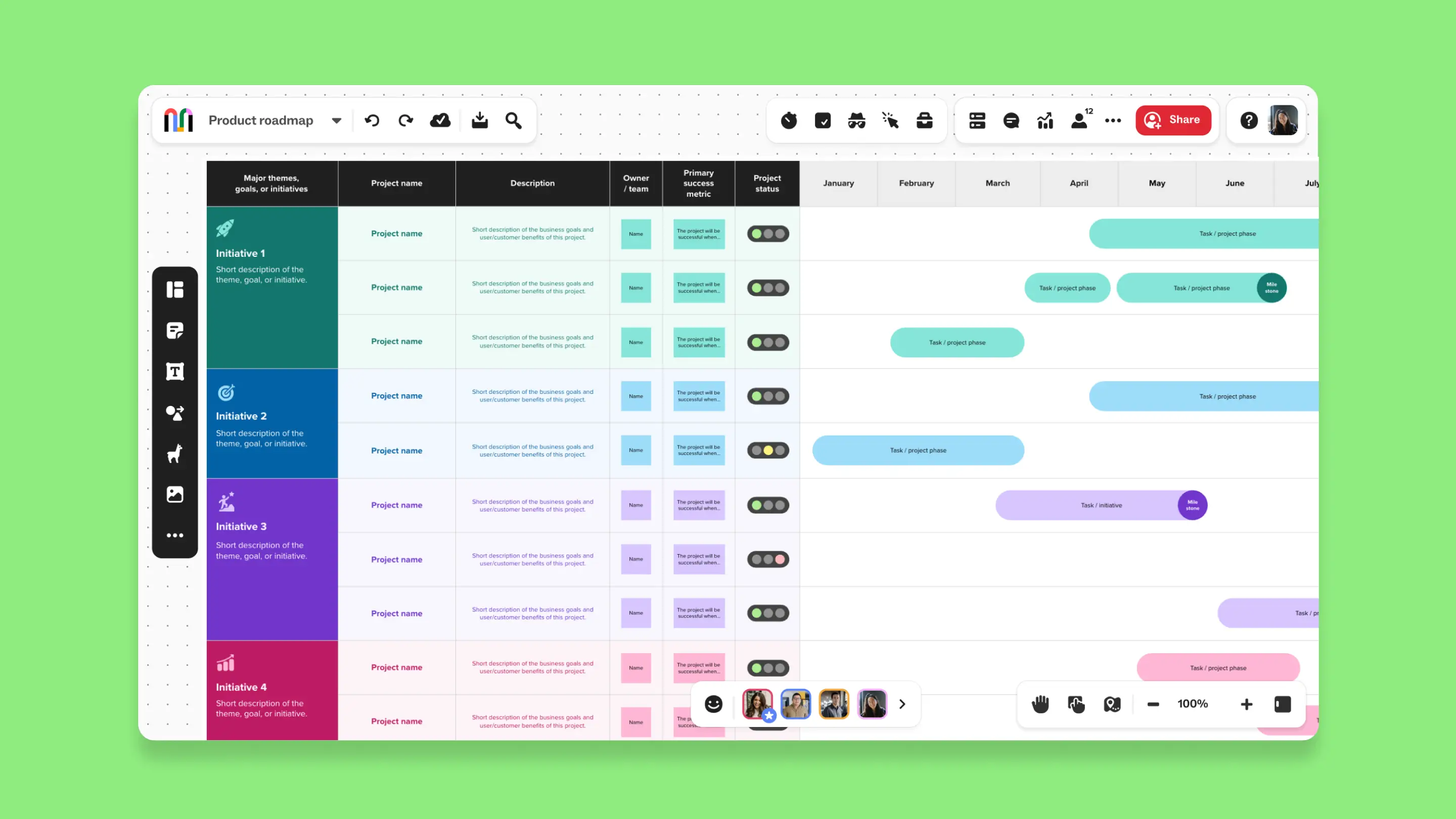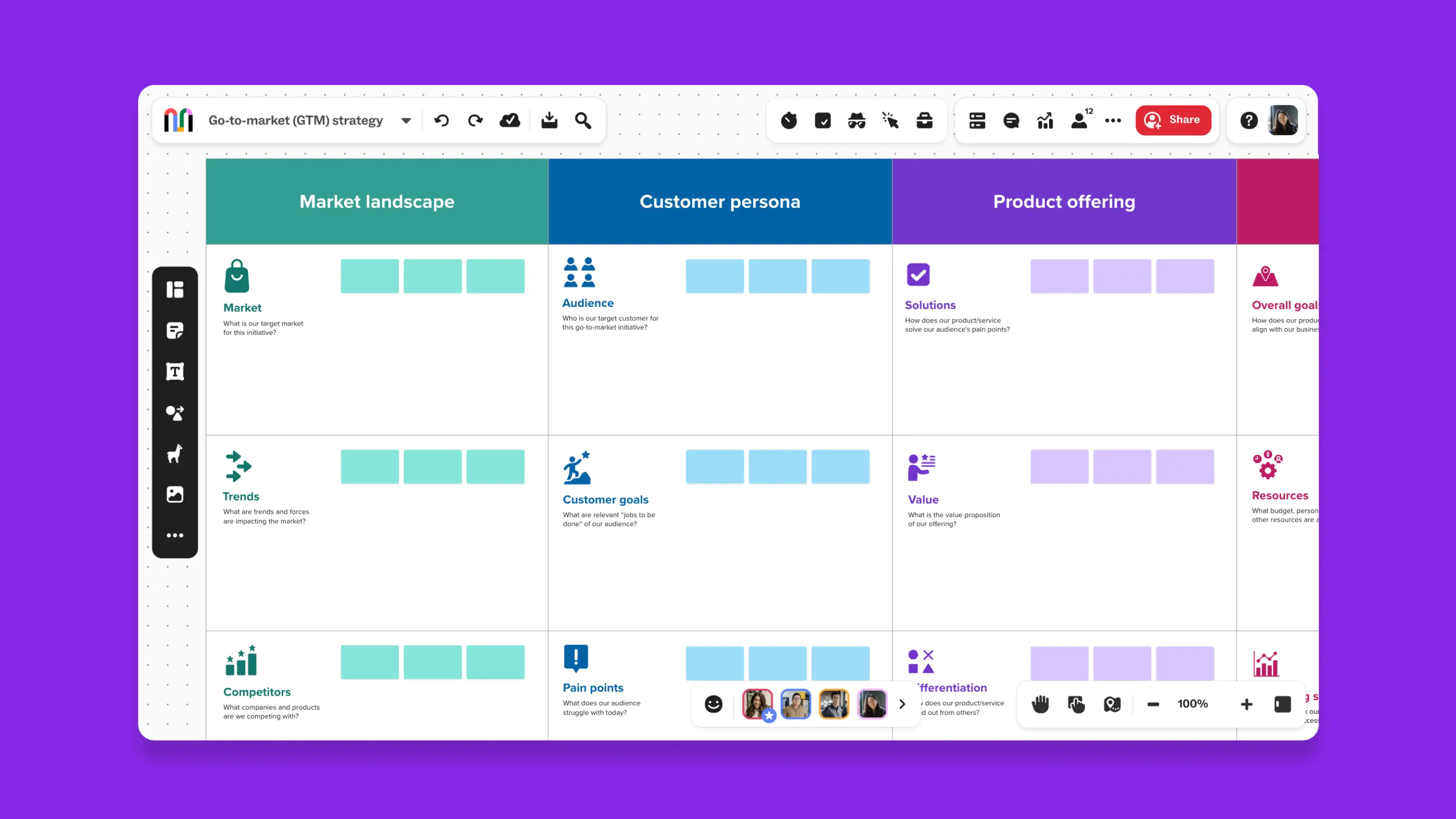It’s easy to get lost on the path to a content launch. Strategy should be your compass, the wayfinding tool that’s helping you overcome obstacles and stay the course. Yet all too often, marketing teams use outdated planning methods to produce vague, inflexible strategies that are difficult to follow. This is where visual roadmaps can make a huge difference, transforming abstract ideas into concrete, actionable plans that foster alignment and set teams on the road to success.
A visual content strategy articulates your strategy in a way words alone cannot, creating an easily digestible blueprint that everyone can understand, contribute to, and rally around. It's the difference between a word-heavy document that sits in a shared drive, unloved and unread, and a dynamic workspace that empowers your entire team.
Why your content strategy needs a visual roadmap
Traditional content planning often relies on spreadsheets or other text-heavy documents that are hard to parse and don’t foster visual collaboration. They can be difficult to read quickly, hard to update in real-time, and present challenges to getting cross-functional buy-in. A visual roadmap, on the other hand, provides a single source of truth that is intuitive, engaging, and accessible to everyone. It helps you see the big picture — literally — while also drilling down into the granular details. It transforms your content strategy planning from a linear, often isolated task into a dynamic, interactive experience.
The core benefits of visual content roadmaps
There are many advantages to adopting visual content roadmaps, impacting everything from efficiency to innovation:
- Enhanced clarity and understanding: Visuals cut through complexity. A well-designed roadmap instantly communicates priorities, timelines, and dependencies in a way that text alone cannot. This clarity ensures that every stakeholder understands their role and how their work contributes to the larger objective.
- Improved cross-functional alignment: Content doesn't live in a vacuum. It impacts and is impacted by sales, product development, customer success, and more. A visual roadmap can be a central hub where go-to-market teams can co-create, share feedback, and ensure their efforts are synchronized. This is particularly important for go-to-market strategy, where seamless handoffs and consistent messaging are a major factor in successful product launches.
- Increased agility and adaptability: The digital ecosystem is constantly evolving, as are the strategies companies need to succeed in digital channels. A static plan that requires a lot of work to revise quickly becomes outdated. Visual roadmaps are inherently more flexible, especially when built on collaborative platforms like Mural. Visual workspaces treat every beat in the roadmap like distinct objects, allowing for quick adjustments, reprioritization, and real-time updates, making it easier to respond to market shifts and emerging opportunities.
- Increase engagement and buy-in: When team members can actively participate in shaping the roadmap, they feel a greater sense of ownership and commitment. Visual tools make it easy for everyone to contribute ideas, vote on priorities, and see their input reflected in the plan. This collaborative spirit transforms passive recipients of information into active contributors to success.
- Streamlined content creation and workflow: By clearly outlining content themes, formats, channels, and owners, a visual roadmap helps to streamline content creation. It acts as a guide for your content workflow, reducing bottlenecks and ensuring a smoother production process. This leads to a more efficient and productive team.
- Better decision-making: With all relevant information visually organized and accessible, teams can make more informed decisions faster. You can quickly identify gaps, redundancies, and areas for optimization, leading to a more impactful content marketing effort.
How visual roadmaps drive go-to-market alignment
For go-to-market teams (typically sales, marketing, and R&D) a shared visual roadmap is not just beneficial; it's transformative. These teams are the engine of new product launches and market penetration, and their success hinges on perfect synchronization.
Imagine a new product launch. Marketing is crafting compelling narratives, sales is preparing their outreach strategies, and R&D is refining the product based on early feedback. Without a shared visual roadmap, these efforts can quickly become fragmented.
A visual roadmap ensures:
- Unified messaging: Marketing and sales can clearly see the key messages, value propositions, and launch phases to support a consistent voice across all customer touchpoints. This is critical for cross-functional alignment content.
- Coordinated campaigns: The roadmap can be used to map out campaign timelines, content assets needed, and distribution channels, helping marketing provide sales with the right materials at the right time.
- Feedback loop integration: R&D can see how their product updates align with upcoming content and sales cycles, and provide input on technical details, while marketing and sales can offer market insights back to R&D. This fosters better sales/marketing/R&D collaboration.
- Clear ownership and accountability: Each piece of content, each campaign phase, and each launch milestone can have clear ownership assigned, reducing confusion and accelerating execution to support your go-to-market strategy.

Leveraging Mural for your content roadmap
As a leading collaboration platform, Mural offers a wide variety of intuitive visual tools for content teams to create and manage dynamic visual roadmaps. Our AI-powered workspace allows you to bring all your content strategy elements to life.
Here's how Mural can empower your team:
- Flexible canvases: Start with a blank canvas or choose from a library of templates to kickstart your content roadmap, such as our content strategy template. You can visually map out content themes, target audiences, channels, and timelines using sticky notes, shapes, and connectors.
- Real-time collaboration: Multiple team members can work on the same roadmap simultaneously, no matter where they’re located. This real-time interaction fosters dynamic brainstorming and ensures everyone's voice is heard.
- Rich media integration: Embed documents, videos, images, and links directly into your roadmap to collect all necessary context in one place.
- Presentation mode: Easily present your content roadmap to stakeholders using Mural's Presentation Mode, ensuring clarity and engagement during reviews. Now you can quickly jump into presentation mode from the toolbar or inside your outline — your content will open in a fullscreen window with a hover bar for easy access to Facilitation Superpowers™ features like Timer, Laser, and Private Mode.
- Templates for success: Mural offers a wide array of pre-built templates that can jumpstart your content strategy efforts. Our Product roadmap template is great for product launches, and it can easily be adapted for content planning. For your GTM efforts, the Go-to-market strategy template is invaluable, and for overall planning, the Project planning template can help you manage your content initiatives.
- Specific use cases: Need more inspiration? Mural’s Marketing use cases page is a good place to see examples of how other marketing teams leverage Mural for their strategic needs.

Mural makes it easy to streamline content creation and improve content workflow with a central, visual hub for all your planning.
Beyond the roadmap: AI for content strategy
In the current tech landscape, I’d be remiss if I didn’t talk about how AI can fit into the picture. Using your visual roadmap as the framework, AI can act as an intelligent assistant that enhances various aspects of your content strategy planning.
Here are a few areas where AI can help making your planning sessions faster and more productive:
- Generating content ideas: AI tools can analyze market trends, competitor content, and audience preferences to suggest new content topics and angles, feeding directly into your roadmap.
- Optimizing Keywords: AI can assist in identifying high-impact keywords and long-tail variations, ensuring your content is discoverable and ranks well. This directly supports your AI for content planning efforts.
- Summarizing and synthesizing: AI can quickly process large amounts of information, summarizing research or meeting notes, which can then be easily integrated into your visual roadmap for quick reference.
- Personalizing content: As AI evolves, it will increasingly help in tailoring content experiences to individual audience segments, a strategic consideration that can be mapped out on your visual roadmap.
Mural's built-in AI features can streamline and accentuate many of the tasks involved in your strategy planning, from sorting and organizing stickies to summarizing and synthesizing blocks of text to automatically building project templates to generating creative ideas based on keywords and prompts. This can help you save time, increase efficiency and productivity, and help take your plans in unexpected, more creative directions.
Building your visual content roadmap: getting started
Ready to harness the power of a visual roadmap for your content strategy? Here’s a simplified approach to get started:
- Define your vision and goals: Before you build your roadmap, know where you're going. What are your overarching business objectives? How will content contribute to them? Use your visual workspace to brainstorm and align on these foundational elements.
- Audit existing content: Know what you have to know what you have to make. What’s performing well? What are the gaps? Visually categorize your existing assets to inform future planning.
- Map your audience journey: Who are you trying to reach? What are their pain points and information needs at different stages? A visual representation of the customer journey can highlight new content opportunities.
- Brainstorm content ideas: Using your vision and audience insights, generate an abundance of content ideas. Use sticky notes, voting, and grouping features in Mural to organize and prioritize.
- Structure your roadmap: Decide on the key phases or themes. This could be by quarter, by product launch, by audience segment, or by content pillar.
- Populate and prioritize: Add your content ideas to the roadmap, assigning owners, deadlines, and key performance indicators (KPIs). Use visual cues like colors or icons to indicate priority or status.
- Collaborate and iterate: Share your roadmap with your go-to-market teams and other stakeholders. Gather feedback, make adjustments, and ensure everyone is aligned. Remember, a roadmap should be a living document, constantly evolving.
- Measure and adapt: Regularly review your content performance against your roadmap goals. Use these insights to refine your strategy and make informed decisions for future content initiatives.
By embracing visual roadmaps, you're not just organizing your content; you're transforming how your teams collaborate, innovate, and achieve shared success. It's a strategic shift that empowers you to develop effective content and marketing strategies using structured plans and visual tools, ultimately driving business transformation.
Ready to visualize your content strategy? Unlock the power of cross-functional collaboration and AI-powered efficiency with a free Mural account today.




.webp)


.webp)





